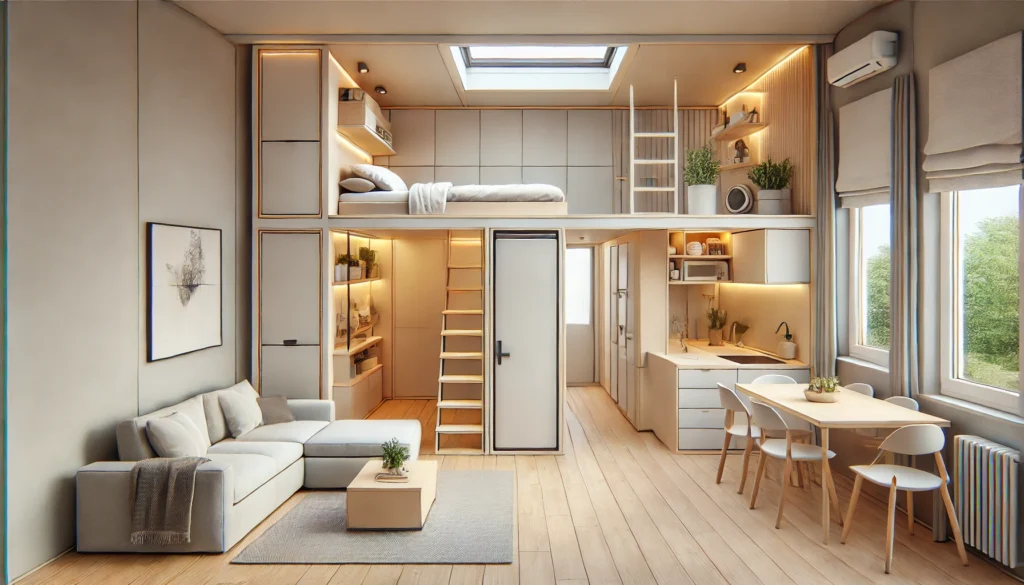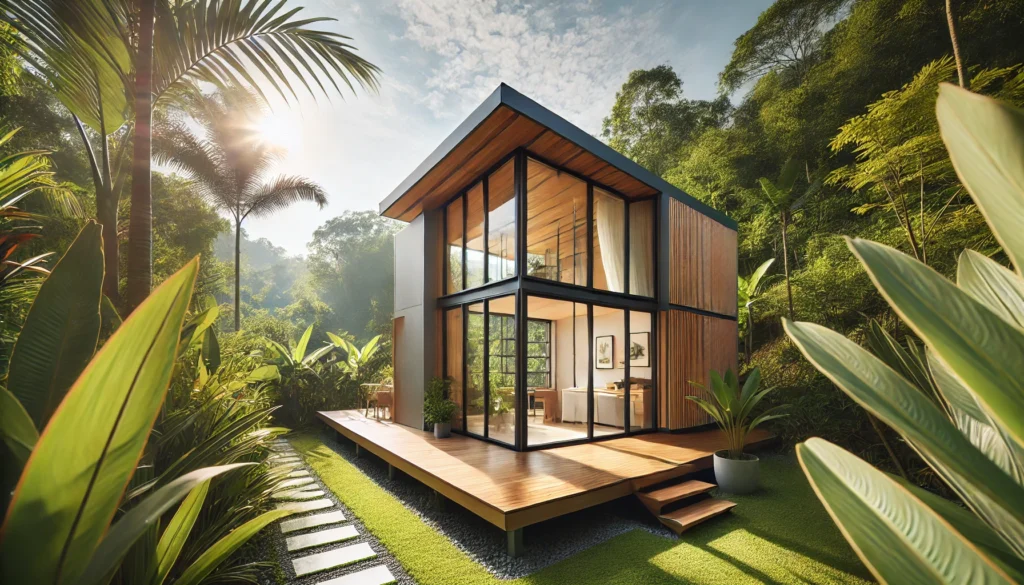Tiny homes have become a global phenomenon, embraced for their minimalist lifestyle appeal, affordability, and environmental benefits. In Malaysia, the tiny house movement is gradually gaining traction, attracting those who wish to live more sustainably or escape from the confines of traditional urban living. This blog explores the design of tiny houses in Malaysia, the benefits they offer, and the challenges that come with embracing this minimalist way of living.
What is a Tiny House?
A tiny house is defined as a dwelling unit that is significantly smaller than a standard home, typically ranging from 100 to 400 square feet. These homes are usually built to maximize efficiency and functionality, often incorporating multi-purpose furniture and compact layouts. Some tiny houses are on wheels, allowing for mobility, while others are stationary. Despite their size, tiny homes are designed to provide all the necessary amenities for comfortable living, including a kitchen, bathroom, sleeping area, and living space.
In Malaysia, the concept of tiny homes resonates with individuals looking for affordable housing alternatives or those who want to downsize their lifestyles. As real estate prices continue to climb in urban areas like Kuala Lumpur, tiny houses offer a cost-effective and minimalist solution for homeownership.
Design of Tiny Houses in Malaysia
1. Architectural Trends
Tiny houses in Malaysia often reflect a combination of modern and traditional architectural styles, blending contemporary designs with local cultural elements. Malaysian tiny homes might incorporate wooden elements from traditional Malay houses (rumah kampung) or adopt minimalist and eco-friendly materials such as bamboo, metal, or concrete. The design emphasis is on practicality, sustainability, and aesthetic appeal.
Here are a few key elements that define the design of tiny houses in Malaysia:
- Open-plan Layout: Open floor plans are essential in tiny homes to create a sense of spaciousness. By reducing the number of walls and partitions, the house feels less cramped, even though it occupies a limited area.
- Multi-functional Furniture: Tiny houses rely on multi-functional and space-saving furniture, such as foldable tables, hidden storage compartments, and lofted beds.
- Sustainable Building Materials: Using environmentally friendly materials like bamboo, recycled wood, and steel not only reduces the carbon footprint but also helps to keep construction costs low.
- Smart Home Technology: Some modern tiny homes in Malaysia integrate smart home features to maximize energy efficiency and convenience. Smart lighting, temperature control, and security systems can be controlled via mobile apps, contributing to a more connected and energy-efficient lifestyle.
2. Customization for Local Climate
The tropical climate of Malaysia necessitates unique design considerations for tiny homes. The hot and humid weather can be challenging for small spaces, so it’s crucial to incorporate ventilation and insulation solutions. Large windows, cross-ventilation, and energy-efficient cooling systems can help keep the interior of the house comfortable. Using reflective roofing materials and insulated walls also ensures the home stays cool during Malaysia’s hot afternoons.
Additionally, rainwater harvesting systems and solar panels are becoming increasingly popular in tiny home designs, further emphasizing eco-consciousness and reducing utility costs for homeowners.
Benefits of Living in a Tiny House in Malaysia
1. Affordability
One of the most attractive aspects of tiny homes is their affordability. Compared to traditional homes, tiny houses require significantly less land, materials, and labor to build. This makes them an ideal option for young homeowners or those who cannot afford the skyrocketing prices of real estate in Malaysian cities like Kuala Lumpur or Penang. In fact, some tiny homes in Malaysia can be built for as low as RM50,000, depending on the design and materials used.
2. Environmental Sustainability
Tiny homes are synonymous with sustainable living. Their smaller size naturally reduces energy consumption for heating, cooling, and lighting. Additionally, many tiny house owners opt for eco-friendly building materials and renewable energy sources, like solar panels. By living in a tiny home, Malaysians can minimize their carbon footprint and contribute to environmental conservation efforts.
3. Simplicity and Minimalism
The tiny house movement promotes a minimalist lifestyle that focuses on reducing clutter and prioritizing experiences over material possessions. Living in a tiny home encourages individuals to downsize their belongings and focus on what truly matters. This shift in mindset often leads to a less stressful, more intentional way of living.
4. Mobility
For individuals seeking freedom and flexibility, tiny homes on wheels offer the ability to move their residence whenever they please. This mobile lifestyle allows for exploration of different parts of Malaysia, from the lush rainforests of Borneo to the bustling streets of Kuala Lumpur. With a tiny house, you are not tied down to a particular location, making it easier to pursue job opportunities, travel, or embrace a more nomadic lifestyle.
Challenges of Tiny House Living in Malaysia
1. Legal and Zoning Issues
One of the main challenges for tiny home enthusiasts in Malaysia is navigating the legal and zoning regulations. While tiny houses are becoming more popular, Malaysian building codes and land use regulations may not yet fully accommodate this unconventional housing style. It’s essential to research local laws regarding building permits, land usage, and whether tiny homes are allowed in certain areas.
Zoning restrictions can limit where you can place a tiny house. For example, some areas may only permit traditional residential structures and might not recognize tiny homes as legal dwellings. Therefore, it’s important to consult with local authorities to ensure compliance with all applicable regulations before starting construction.
2. Limited Space and Storage
Although tiny homes are designed to maximize every square inch, the limited space can be challenging, especially for families or those with extensive belongings. Downsizing is essential when transitioning to a tiny home, and many people find it difficult to part with their possessions. Moreover, storage options in tiny homes are minimal, so homeowners must be creative in finding solutions to store essential items.
3. Climate Control
Malaysia’s tropical climate poses a challenge for tiny house dwellers, particularly when it comes to managing humidity and heat. Without proper ventilation and cooling systems, tiny homes can become uncomfortable, especially during the hot season. Homeowners need to invest in energy-efficient air conditioning systems or innovative passive cooling techniques, such as installing roof insulation, to maintain a comfortable living environment.
4. Social Stigma and Acceptance
While tiny houses offer many benefits, they are still considered unconventional in Malaysia. Social acceptance can be a hurdle, as some people may perceive tiny houses as inferior or inadequate compared to traditional homes. This stigma may affect how tiny house owners are perceived within their communities, though this is likely to change as the tiny house movement becomes more mainstream.

Pro Inspect Solution: Ensuring the Structural Integrity of Tiny Homes
Building a tiny home requires careful planning and consideration of structural safety, particularly in Malaysia’s diverse environmental conditions. Pro Inspect Solution offers professional property and building inspection services in Malaysia, ensuring that tiny homes meet local building codes and are structurally sound. Their services include comprehensive inspections of foundations, roofing, plumbing, and electrical systems. Whether you’re building a stationary tiny home or a mobile one, Pro Inspect Solution can help you avoid costly mistakes and ensure the safety of your home.
For more information about our services, visit Pro Inspect Solution.
Conclusion
The tiny house movement in Malaysia is steadily gaining traction, offering an appealing solution for those seeking affordability, sustainability, and a minimalist lifestyle. With thoughtful design, innovative use of space, and a focus on environmental impact, tiny houses can provide a unique and fulfilling living experience. However, it’s crucial to consider the challenges, including legal and zoning hurdles, limited space, and the need for climate control in Malaysia’s tropical environment.
As more Malaysians explore this alternative housing option, tiny homes may become a viable solution to rising real estate costs and growing urbanization pressures. Whether you’re drawn to the minimalist lifestyle, looking to reduce your environmental footprint, or searching for a flexible living arrangement, tiny houses present a new way of thinking about homeownership. With the right planning, local compliance, and professional inspection services like those offered by Pro Inspect Solution, building or purchasing a tiny home in Malaysia can be a rewarding and worthwhile investment.
FAQ About Tiny House
How much is a tiny house in Malaysia?
The cost of a tiny house in Malaysia can vary significantly depending on the design, materials used, and location. On average, a basic tiny house may cost between RM50,000 to RM200,000. The lower end of the spectrum involves more DIY projects, while professionally built tiny homes with high-end finishes can cost more.
What is the definition of a tiny house?
A tiny house is typically defined as a residential unit that is smaller than 400 square feet. These homes are designed to maximize space and functionality while providing all the necessary living amenities in a compact form.
What is the smallest size house I can build?
The smallest size house you can build in Malaysia depends on local building regulations and zoning laws. Generally, tiny houses range from 100 to 400 square feet, but it’s essential to check with local authorities to determine the minimum size requirements for legal construction in your area.
Where are tiny homes most popular?
Tiny homes are most popular in countries like the United States, Australia, New Zealand, and Japan, where the tiny house movement has grown significantly in recent years. However, the trend is also gaining momentum in Southeast Asia, including Malaysia, as people explore more affordable and sustainable housing options.
What country has the most tiny houses?
The United States currently has the most tiny houses, as the movement originated there. With thousands of tiny house communities and a wide range of enthusiasts, the U.S. continues to lead the trend toward minimalist and small-scale living.
Who buys the most tiny homes?
Tiny homes appeal to a wide demographic, but they are particularly popular among millennials, retirees, and individuals looking to downsize or simplify their lives. Young professionals who are unable to afford traditional homes and older individuals seeking to minimize their lifestyle are among the largest buyers of tiny homes.


